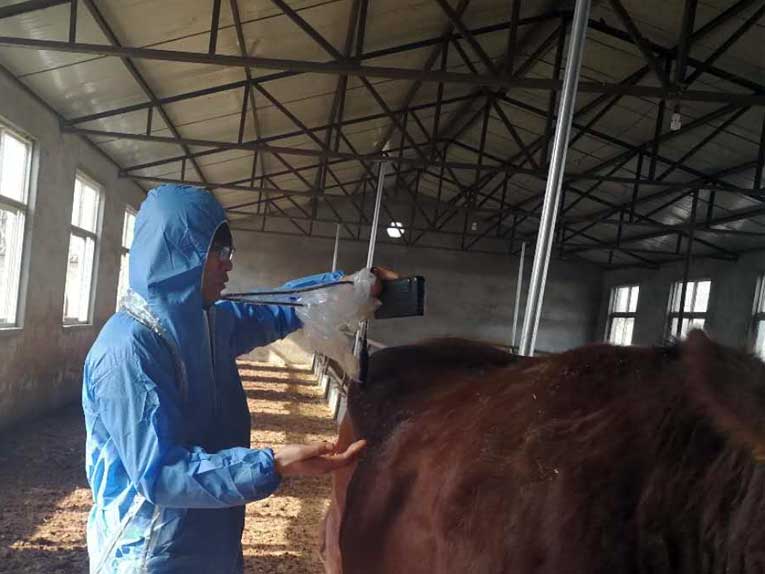1. Define Your Primary Use Case
Start by clarifying whether you need the equipment primarily for cattle pregnancy ultrasound machine applications or broader diagnostic purposes.
Pregnancy Detection: Look for machines optimized for early-stage pregnancy confirmation (as early as 28–35 days). These devices prioritize clarity in visualizing fetal structures and placental fluids.
Disease Diagnosis: If assessing conditions like ovarian cysts, uterine infections, or liver health, choose a system with higher resolution and advanced imaging modes (e.g., Doppler for blood flow analysis).
2. Prioritize Image Quality and Resolution
High-resolution imaging is non-negotiable for accurate diagnoses. Key factors include:
Probe Frequency: For rectal exams in cattle, a 5–7.5 MHz linear rectal probe is standard. Lower frequencies (3.5 MHz) may be needed for deeper tissue imaging in larger breeds.
Dynamic Range and Power Output: Ensure the system offers adjustable settings to optimize images across varying tissue densities.
3. Evaluate Probe Design and Durability
The probe is the most critical component of ultrasound equipment for cattle. Consider:
Ergonomic Design: A lightweight, waterproof probe with a long cable (1.5–2 meters) ensures comfort during prolonged rectal exams.
Durability: Farm environments demand rugged, shock-resistant probes. Opt for models with IP67 waterproof ratings to withstand cleaning and harsh conditions.
4. Portability and Battery Life
For fieldwork, prioritize portable cattle ultrasound machines with:
Long Battery Life: 4–6 hours of continuous use per charge is ideal for all-day operations.
Compact Size: Handheld or cart-based systems are easier to transport between barns or pastures.
Sunlight-Readable Screens: A 10–12-inch display with anti-glare technology ensures visibility outdoors.
5. User-Friendly Interface and Software
Simplify training and daily use with:
Pre-Set Modes: Look for dedicated modes for cattle pregnancy ultrasound (e.g., fetal aging, twin detection).
Image Optimization Tools: Automatic gain adjustment, focus zones, and measurement presets (e.g., fetal crown-rump length) save time.
Data Management: Built-in storage or cloud compatibility for saving images and generating reports.
6. Brand Reputation and Support
Choose established manufacturers specializing in veterinary ultrasound equipment:
Warranty and Service: Ensure at least a 2–3-year warranty and access to technical support.
Training Resources: Providers should offer tutorials or on-site training for proper probe handling and image interpretation.
7. Cost vs. Value
While budget matters, avoid sacrificing quality for lower prices:
Entry-Level Systems: Suitable for basic pregnancy checks (e.g., Dawei Veterinary S1 handheld models).
Mid-Range to High-End: Invest in systems like E.I. Medical’s Ibex® Pro or Samsung’s VET H60 for advanced diagnostics and durability.
8. Test Before Buying
Request a demo or trial period to assess:
Image clarity in real-world conditions.
Ease of cleaning and maintenance.
Compatibility with your workflow (e.g., single-handed operation).
FAQs: Cattle Ultrasound Equipment
Q: Do I need specific training to use a cattle pregnancy ultrasound machine?
A: Yes, proper training ensures accurate probe placement and image interpretation. Many suppliers offer courses.
Q: How often should the equipment be calibrated?
A: Annual calibration is recommended, especially for machines used daily.
Q: Can one machine work for both cows and smaller livestock?
A: Yes, but ensure the probe frequency and software settings are adjustable for different species.
Q: Are refurbished systems reliable?
A: Only if sourced from reputable vendors with updated software and warranty coverage.
Key Takeaways
For cattle pregnancy ultrasound, prioritize portability, probe ergonomics, and early-detection capabilities.
Invest in durable, high-resolution ultrasound equipment for cattle to maximize ROI through accurate herd management.
Partner with trusted brands to ensure technical support and long-term reliability.
By focusing on these factors, you’ll select a system that enhances productivity, improves animal health outcomes, and streamlines your cattle management operations.
Post time: Apr-03-2025



